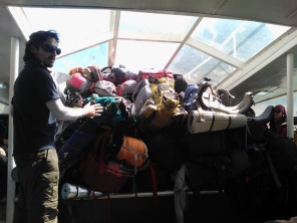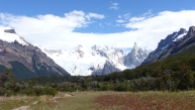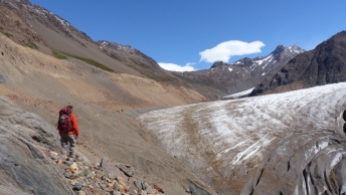 We started our journey north, following the Andes, in Tierra del Fuego, where the very southern peaks are smaller but magical, covered in snow. From there, the roads north take you back into the desert of the Patagonian steppe, with the mountains usually not far from view to your left. Only forays into the national parks along the eastern edge of the range are possible by road – but those encounters with some dramatic massifs have been breathtaking…
We started our journey north, following the Andes, in Tierra del Fuego, where the very southern peaks are smaller but magical, covered in snow. From there, the roads north take you back into the desert of the Patagonian steppe, with the mountains usually not far from view to your left. Only forays into the national parks along the eastern edge of the range are possible by road – but those encounters with some dramatic massifs have been breathtaking…
Bruce here…
1. Tierra del Fuego
The first of the three national parks that we explored in the Southern Andes was the Parque National de Tierra del Fuego, just to the west of Ushuaia. Strictly speaking, the peaks on Tierra del Fuego may not be defined as part of the Andes range, as they are not on the South American continent itself, but geologically they are all one range, that starts even further south with the Antarctic Peninsula – where you could say our Andean adventure really began.
The park has several lovely campsites and so we chose to camp at what was reputed to be the best free one (Rio Pipo), which is situated next to the track of a little narrow gauge steam railway (originally built and used by prisoners to collect wood for a remote Argentinian prison in the early 20th Century, now reopened as a tourist line), which provided some entertainment over breakfast. The campsite also has the distinction of having the best portaloos I have ever seen – clean, toilet roll, soap, running water, paper hand towels and still in good nick on the second day! We parked up with Paula and Jeremy of seventeenbysix.com, a couple from London whose blog of their trip south from California we had read before we came out. So it was a pleasure to spend some time with them when they arrived in Ushuaia after 3½ years on the road. They are also in a VW campervan and we sat with both vans surrounded by free roaming horses in the picturesque setting of the park.
Most of the peaks around here are only around 1,400m, which is not very high but they all have snow on and come up dramatically straight out of the sea. One of the easiest to get up is Cerro Guanaco, which overlooks the campsite. We had been advised to only do the 6km trek up the 965m summit if you can see the top when you get up in the morning. We were lucky and had a beautiful, albeit windy (as always), day giving us fantastic views across the Beagle Canal from the top. The hike also gave us our first taste of walking in the Patagonian winds, which can be very fierce. We learnt that trekking poles have another use as a walking aide here – bracing yourself against gusts. This felt like a good start to our Andes hiking and we also followed it with a half day of climbing at what is probably the most southerly bolted crag in the world. Short, quite tough and overhanging but great views of the Beagle Channel surrounded by snow-capped mountains – a unique cragging experience!
On the way to our next appointment with the Andes, we managed to catch sight of yet another species of penguin: the King penguin – similar to, but slightly smaller than, the famous Emperor penguin. Our first “proper” penguins, according to Becca, and they are certainly more magisterial than their small cousins whom we had seen so far – a real treat to see. A quick, unplanned, pitstop followed in Punta Arenas to repair our rear shock absorbers, which had suffered from the many thousands of kms travelled on unfinished roads, before we could get back on the road north to the Parque National Torres del Paine…
2. Torres del Paine
As we approached, we could see that we were now starting to see something much bigger and more dramatic – Paine Grande is a smidgin over 3,000m. The Torres del Paine is a range of rock massifs protruding dramatically out of their surroundings. It is also relatively approachable, being right on the eastern edge of the range, meaning that it is now also a huge tourist destination. Many of our fellow passengers to Antarctica went there either before or after the voyage and, at the height of the summer holidays, there were 1,000s of visitors, a few doing a 5-6 day trek circling the entire massif, the majority doing a 5 day ‘W’ trek around the eastern side. That being said, it was good to see that most of the tourists are Chilean, reflecting how well developed the healthy Chilean economy is – indeed it almost seemed like doing the ‘W’ might be some sort of right of passage for Chilean teenagers!
Each arm of the ‘W’ is a foray into a valley in, or up the side of, the massif. There are plenty of campsites and refugios, but the refugios need to be booked a long time in advance in summer (impractical for us) and even some of the campsites need places reserving. They are basic but well run and in general, the crowd management of the area is pretty well done. There is very little litter and none of the tissues scattered around that you see in lots of other parts of the world. But you are not able to walk in solitude for any length of time at the time of year we were there!
We decided to do two separate treks, involving two two-day hikes, one day in and the other out, to see a couple of the legs of the ‘W’. We started by going up the valley to see the Torres (towers) themselves and then went up the middle arm, the Valle Frances. The Torres were stunning to see, but the walk itself was much less interesting than the dramatic and varied Valle Frances, which gave us stunning views of Paine Grande and it’s glaciers (creaking and cracking all the time) on the west and the Cuernos (horns) on the right. Both walks were a fun introduction to multiday trekking for us and were a good test of our little, previously unused, trekking tent.
After a satisfying week or so, we watched the Torres disappear in our rear view mirror as we headed back into Argentina to continue our journey north, stopping on route to visit the Milodon Cave, just south of Torres del Paine, known for it’s fossil remains of a huge ground dwelling sloth, which was around for a while after the last ice age, coinciding with the first human inhabitants, but went extinct about 6-8,000 years ago – another reminder of the glacial forces that shaped Patagonia.
3. Los Glaciares
Next we were off to spend a couple of weeks at the Parque National Los Glaciares. The first few days were spent at the southern end in El Calafate, primarily to go and see the massive Perito Moreno glacier. This is about 6km across the front and, is unusual, because it is advancing, moving about 2m a day into Lago Argentina, making it very active, with frequent “calving” (when bits melt and break off the front). You can get very close to it, as it advances towards a point of land directly opposite, from which there are spectacular views from viewing platforms.
The northern part of the park is centred around the small town of El Chalten, which is a kind of a cross between Chamonix in the early days and Camp Four at Yosemite (for those who are interested). The park here is free to enter and is the gateway to the big boys – Monte Fitz Roy (3,405m) and Cerro Torre (3,102m), which, like the Torres, are sheer rock massifs. The town is very remote, the one petrol pump is solar and wind powered and internet access almost non-existent, but it has a great outdoor feel about it and we stayed for much longer than we expected. There is plenty of trekking, most of it easily done in a long day and we did one one-day walk as a warm up to get close up views of Cerro Torre.
Both Torres del Paine and Los Glaciares are on the edge of the massive South Patagonian Icefield, which is only beaten in size by the two Poles. It has a noticeable affect on the weather, making the wind that comes across it rather chilly. The main manifestation of the icefield that most people can see are the glaciers creeping out of the icefield into the lakes. Not having any experience with ice, crampons etc., we took a tourist trip onto one of the glaciers, and it was there, we got a little tantalising view of the icefield behind. Becca asked the guide if there was somewhere reachable by ordinary walkers to see the icefield properly and was told that the Paseo del Viento (windy pass) was the most easily reached place. We needed kit and expertise to do a Tyrolean traverse (a crossing on a suspended rope or wire), which, being rock climbers, we have, but the glacier crossing would be fine in ordinary boots, as the glacier is “dry” and covered in rocks and stones at that point. So, we decided to made that our major trek of our stay here and waited for a “weather window” to do it.
We only had to wait one day until it looked like we could catch a clear, fine day for going up to the pass. Overall, the three days were quite long and hard, but well worth it for the view. This was not one of the standard day hikes and so required registration and a (free) permit from the Guardaparque (who were very helpful and a good source of information, although they were at pains to point out that they won’t come rushing to find and rescue us just because we don’t check back in, back from our trek, on time – fair enough really). We can also say that we have been inaugurated into the true Patagonian trekking experience having spent two very windy and wet nights squeezed, with all our stuff, into our tent camped by the lake near the top of the valley, either side of the fine day we had going up to the pass!
From a climbing point of view, most serious climbers go to Los Glaciares to climb Fitz Roy, Cerro Torre or one of the other imposing rock peaks in the park. However, if you are not such a gnarled and serious a climber, there is also a wealth of cragging and bouldering available within short walking distance of the town, including the 180m long ‘Carsten Route’, which is one of the best sports routes I have ever done! (Made possible by coinciding with the “Hot Rock” overland truck being in town at the same time and lending me a climbing buddy for the route – thanks Callum!) All-in-all, the climbing and trekking managed to keep us there for 11 nights – a record for us on this trip so far.
One of the things that all three parks had in common was the flora, fauna and the threats to them. There are only four or five species of hardy trees (mostly beech species) and a couple of bushes (including the famous Calafate) that are found in the Southern Patagonian Andes but they are quite abundant, slow growing and long lived. This makes the landscape quite magical, with their gnarled limbs, but also means that they are extremely vulnerable to damage. In the 1950s, about 25 pairs of beavers were introduced to Tierra del Fuego, we think with the intention of creating a fur industry, and their damns have devastated many rivers and killed countless trees throughout Tierra del Fuego. Further north, fire damage is the most significant risk and a number of recent fires caused by trekkers have destroyed swathes of woodland in Torres del Paine. The problem is that the trees are so slow growing that it takes decades for them to get established again and in the meantime what is left is open fields littered with the hulks of dead grey tree trunks.
Oh and did I mention the wind? Sixty kilometres an hour gusts are very common and it can be relentless for days on end. On clear sunny days, with no wind, you could believe it was summer, but those days are very few in number. Our guide on our visit to Haberton, an ex-sheep farming estancia set on the Beagle Chanel, who was clearly missing the heat of Buenos Aires, informed us sadly that you could count the days like that each year on the fingers of one hand. If the sun goes in, or the cold wind gets up, or worse, both, it feels more like the end of winter to us. How can it be “summer” if we can’t venture out without a down jacket and a woolly hat, however much the locals jokingly tell us that this is warm!! We travel on looking forward to feeling hot again…
A lot of pictures this time, but it has been three remarkable places:









































































































































Fab pics all of them! We’re going through the “what vehicle” stage now and aiming to ship to Halifax Nova Scotia and do the top down route. Quick question, what do you do for showering etc as VW T5 does not have this facility built in. That’s why we may go for Sprinter 4×4 as tad larger van with bog in the back 😉
Safe driving on the roads ahead and we may cross paths with you later in the year. Regards from London England (not Ontario)
Digby & Martine xx
LikeLike
Hi guys, welcome to the planning stages! Showering??!! I’m afraid overlanders get quite used to going a good few days between showers at campsites. Many rigs do have showers and I can’t comment on using them, except to say I would probably only want to so in places where keeping your water supply topped up is no issue. We decided not to have internal plumbing at all (we went for as much simplicity as possible) and just have jerry cans of water plus bowls for hand washing etc when in the wilds. We do have “solar showers” (basically sun-heated water bags) and we have a shower head with pump powered by 12v that you can stick in a bucket that we may make use of rigged up off the side of the van in warmer climes… maybe by a tropical sea… (she says dreamily…)
The Sprinter may be worth going for because of the higher roof (plus spare parts may be more readily available). We got something low enough to fit in a standard shipping container, but neither of us can stand up in it and I don’t think it’s any more complicated or expensive to get a taller container. But then again we never have problems with car parks with height restrictions and can drive almost like a large car. Trade offs, trade offs…
Enjoy choosing and prepping – happy to answer any other questions and hope to meet you on the road one day!
LikeLike
Hello both, thx for the reply – appreciated. We sent an email to a German couple using a Ducato van from Bavaria Camp which they shipped to BA Argentina to start their overland journey. We’ve considered doing something similar but instead shipping to Halifax Nova Scotia for a North to South drive down the PanAm. Bit worried though that the Ducato camper van does not have 4×4 and smaller tyres mean lower clearance. We’ll keep dipping into your news and wish you safe driving! Adios from London ~ Digby & Martine xx
LikeLike
Pingback: Rock climbing in Argentina: A land of plenty | Yellow Van Days